A new iguana specie named Wang's garden lizard was discovered in China following a series of field surveys in the southern portion of the country. Experts were able to collect a number of specimens of the Calotes versicolor species complex.
They found out that the population of what was thought as the Calotes versicolor in South China and Northern Vietnam was a new undescribed species and two subspecies.
Distinctive Orange Tongue of New Iguana Species

Wang's garden lizard (Calotes wangi) is described as less than 9 cm long, and one of its distinguishing features is its orange tongue.
This species can be distinguished from all known congeners by a combination of morphological characteristics and genetic divergence in the mitochondrial tRNA, ND2, and CO1 genes. Molecular phylogenetic analysis revealed that the new species was formed as a monophyletic group and that considerable genetic divergence existed between its congeners (minimum p-distance, 4.6%).
They said that Calotes wangi sp. nov. is distinguished by a combination of the following characteristics: average SVL < 90 mm for adult males; 10-14 dorsal eyelid scales; scales on side of neck and adjacent shoulder area pointing obliquely upward; keels on neck scales weakly to strongly developed; fold in front of the shoulder absent; pair of dark triangular patches extending from the front of the shoulder to the jaw angles; and orange coloration of the tongue.
Following the discovery of this species, it was found that the Calotes wangi sp. nov. is similar to C. irawadi but differs in having scales between the nasal shield and the orbit and a fourth toe with a claw that can reach between the eyes and tympanum.
In the field surveys, researchers found that the populations of C. wangi sp. nov. were relatively large, and the species is not threatened at present.
However, in some areas, their habitat was found to be being fragmented. In addition, the species' bodies are used medicinally and the lizards are also eaten.
Experts suggested that the local government strengthen the protection of their ecological environment and pay close attention to the population dynamics.
Inactive Reptiles
The American Museum National History said that iguanas are not very active animals. Most of the time these tree-dwellers do not move much, blending into the forest canopy to avoid being noticed by the predators. When they do move, they appear sluggish, but they are often capable of picking up the pace if pursued.
Iguanas usually depend on their environment to maintain their body temperature. Several anatomical features help them regulate their body heat, including their distinctive dewlaps, the large flaps of skin under their chin. At lower body temperatures, the lizards' skin is darker to absorb more sunlight.
Meanwhile, as the iguana warms up, their skin grows paler to better reflect the rays. Iguanas are known to be great swimmers and will try to escape a predator by diving into a body of water, then using its tail to propel itself away.
It was observed that if flight is not an option, an iguana will threaten with its dewlap and bob its head aggressively, whipping its long tail, which is studded with spines.
Related Article : Frozen Iguana Season: Iguanas Fall From Trees as Temperatures in Florida Drop for Winter
© 2026 NatureWorldNews.com All rights reserved. Do not reproduce without permission.





